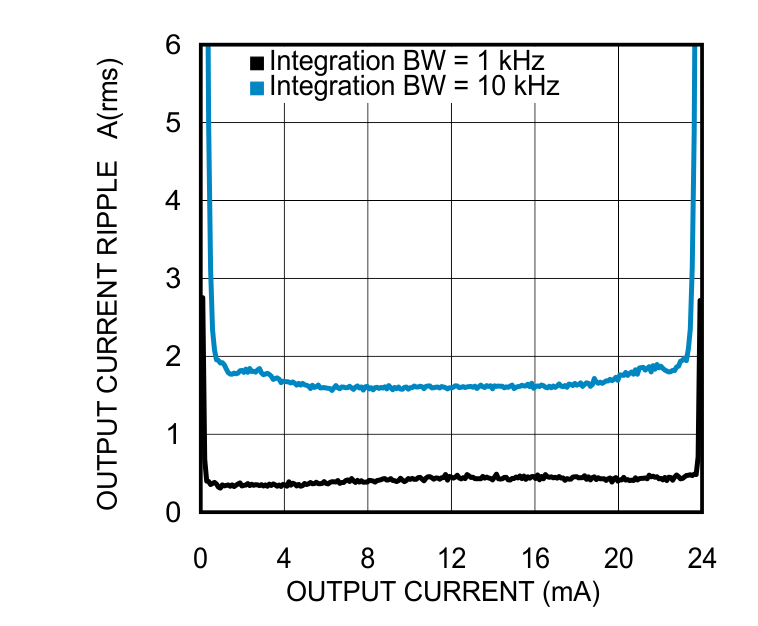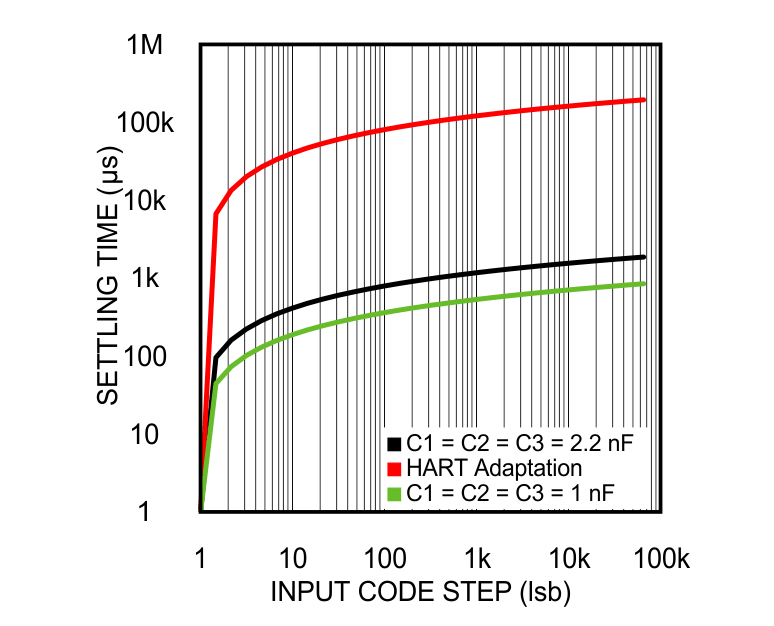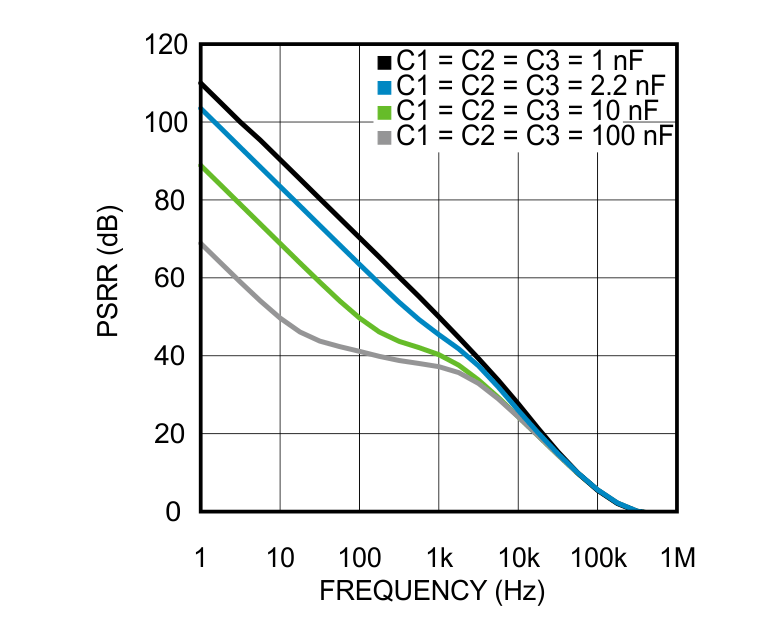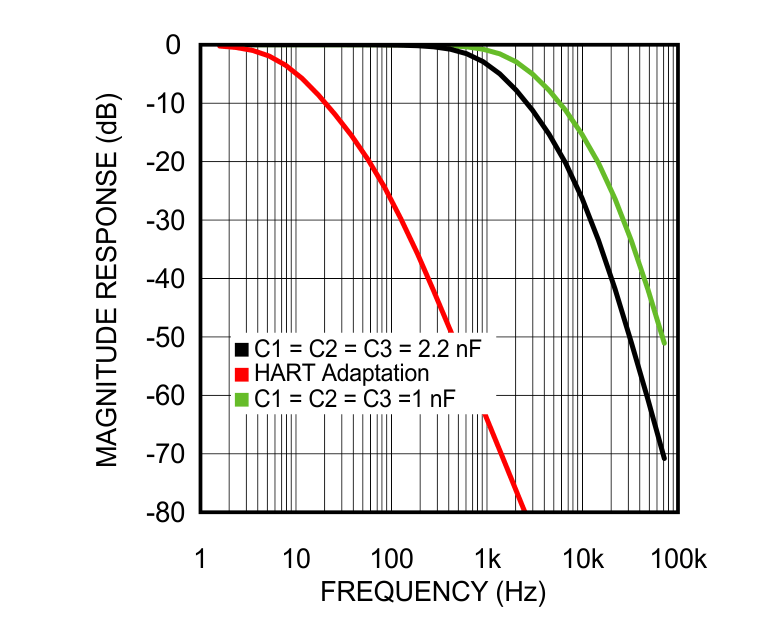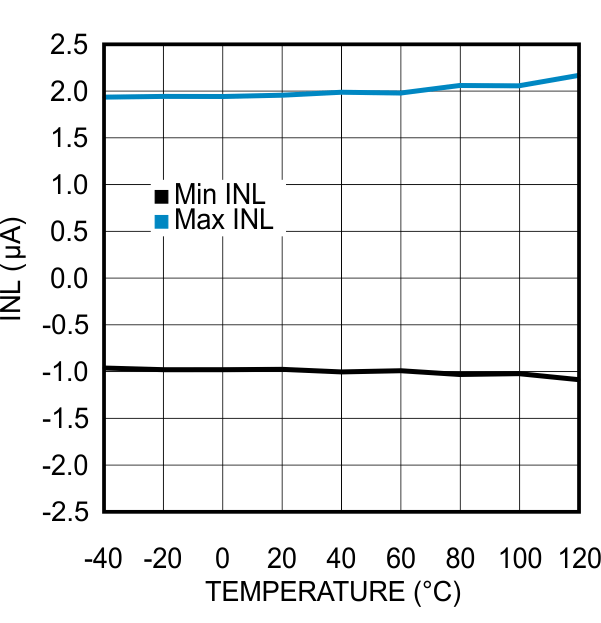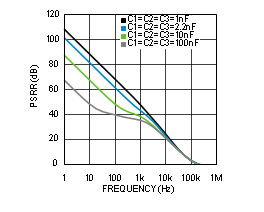SNAS621A JUNE 2013 – December 2014 DAC161S997
PRODUCTION DATA.
- 1 Features
- 2 Applications
- 3 Description
- 4 Simplified Schematic
- 5 Revision History
- 6 Pin Configuration and Functions
- 7 Specifications
- 8 Detailed Description
- 9 Application and Implementation
- 10Power Supply Recommendations
- 11Layout
- 12Device and Documentation Support
- 13Mechanical, Packaging, and Orderable Information
Package Options
Mechanical Data (Package|Pins)
- RGH|16
Thermal pad, mechanical data (Package|Pins)
- RGH|16
Orderable Information
7 Specifications
7.1 Absolute Maximum Ratings(1)
| MIN | MAX | UNIT | ||
|---|---|---|---|---|
| Supply voltage (VA, VD to COMA, COMD) | –0.3 | 6 | V | |
| Voltage between any two pins(2) | 6 | V | ||
| Current IN or OUT of any pin — except OUT pin(3) | 5 | mA | ||
| Output current at OUT | 50 | mA | ||
| Junction Temperature | 150 | °C | ||
| Operating Temperature | –40 | 105 | °C | |
| Storage temperature, Tstg | –65 | 150 | °C | |
(1) Stresses beyond those listed under Absolute Maximum Ratings may cause permanent damage to the device. These are stress ratings only, and functional operation of the device at these or any other conditions beyond those indicated under Recommended Operating Conditions is not implied. Exposure to absolute-maximum-rated conditions for extended periods may affect device reliability.
(2) All voltages are measured with respect to COMA = COMD = 0 V, unless otherwise specified.
(3) When the input voltage (VIN) at any pin exceeds power supplies (VIN < COMA or VIN > VA), the current at that pin must not exceed 5 mA, and the voltage (VIN) at that pin relative to any other pin must not exceed 6 V. See for Pin Descriptions for additional details of input structures.
(4) The Human Body Model (HBM) is a 100 pF capacitor charged to the specified voltage then discharged through a 1.5 kΩ resistor into each pin.
7.2 ESD Ratings
| VALUE | UNIT | |||
|---|---|---|---|---|
| V(ESD) | Electrostatic discharge | Human-body model (HBM), per ANSI/ESDA/JEDEC JS-001(1)(4) | 2000 | V |
(1) JEDEC document JEP155 states that 500-V HBM allows safe manufacturing with a standard ESD control process.
7.3 Recommended Operating Conditions
| MIN | MAX | UNIT | ||
|---|---|---|---|---|
| BASE load to COMA | 0 | 15 | pF | |
| (COMA - COMD) | 0 | V | ||
| OUT load to COMA | none | |||
| (VA - VD) | 0 | V | ||
| VA, VDD | Supply voltage | 2.7 | 3.6 | V |
| TA | Temperature | –40 | 105 | °C |
7.4 Thermal Information
| DAC161S997 | UNIT | |||||
|---|---|---|---|---|---|---|
| WQFN | ||||||
| 16 PINS | ||||||
| RθJA | Package thermal impedance(1) | 35 | °C/W | |||
(1) The package thermal impedance is calculated in accordance with JESD 51-7.
7.5 Electrical Characteristics
Unless otherwise noted, these specifications apply for VA = VD = 3.3 V, COMA = COMD = 0 V, TA= 25°C, external bipolar transistor: 2N3904, RE = 22 Ω, C1 = C2 = C3 = 2.2 nF.| PARAMETER | TEST CONDITIONS | MIN(7) | TYP | MAX(7) | UNIT | |
|---|---|---|---|---|---|---|
| POWER SUPPLY | ||||||
| VA, VD | Supply voltage | VA = VD -40°C ≤ TA ≤ 105°C |
2.7 | 3.6 | V | |
| VA supply current | DACCODE = 0x0200(1) | 43 | µA | |||
| VD supply current | 57 | µA | ||||
| ICC | Total supply current | 100 | 125 | µA | ||
| DC ACCURACY | ||||||
| N | Resolution | 16 | bits | |||
| INL | Integral non-linearity(6) | 0x2AAA < DACCODE < 0xD555 (4 mA < ILOOP < 20 mA) |
–1.5 | 2.6 | µA | |
| DNL | Differential non-linearity | see (2) | –0.2 | 0.2 | µA | |
| TUE | Total unadjusted error | 0x2AAA < DACCODE < 0xD555 | 0.01 | %FS | ||
| OE | Offset error | see (3) | –7.86 | 0.84 | 7.86 | µA |
| ΔOE | Offset error temperature coefficient | -40°C ≤ TA ≤ 105°C | 0.48 | ppmFS/°C | ||
| GE | Gain error | see (4) | 0.007 | %FS | ||
| ΔGE | Gain error temperature coefficient | -40°C ≤ TA ≤ 105°C | 5 | ppmFS/°C | ||
| IERRL | LOW ERROR current | ERR_LOW = default | 3.36 | 3.375 | 3.39 | mA |
| IERRH | HIGH ERROR current | ERR_HIGH = default | 21.70 | 21.75 | 21.82 | mA |
| LTD | Long term drift — mean shift of 12 mA output current after 1000 hours at 150°C | 90 | ppmFS | |||
| LOOP CURRENT OUTPUT (OUT) | ||||||
| IOUTMIN | Minimum output current | Tested at DACCODE = 0x01C2(5) | 0.19 | mA | ||
| IOUTMAX | Maximum output current | Tested at DACCODE = 0xFFFF | 23.95 | mA | ||
| ROUT | Output impedance | 200 | MΩ | |||
| COMA to OUT voltage drop | IOUT = 24 mA | 960 | mV | |||
| BASE OUTPUT | ||||||
| IOUTSC | BASE short circuit output current | BASE forced to COMA potential | 10 | mA | ||
| DYNAMIC CHARACTERISTICS | ||||||
| Output noise density | 1 kHz | 20 | nA/rtHz | |||
| Integrated output noise | 1 Hz to 1 kHz band | 300 | nARMS | |||
| INTERNAL TIMER | ||||||
| TM | Timeout period | Default setting of TIMEOUT in CONFIG register | 100 | ms | ||
| DIGITAL INPUT CHARACTERISTICS | ||||||
| IIN | Digital input leakage current | –10 | 10 | µA | ||
| VIL | Input low voltage | 0.2 × VD | V | |||
| VIH | Input high voltage | 0.7 × VD | V | |||
| CIN | Input capacitance | 5 | pF | |||
| DIGITAL OUTPUT CHARACTERISTICS | ||||||
| VOL | Output Low voltage | Isink = 200 μA | 0.4 | V | ||
| VOH | Output HIGH voltage | Isink = 200 μA | 2.6 | V | ||
| IOZH, IOZL | TRI-STATE leakage current | –10 | 10 | µA | ||
| COUT | TRI-STATE output capacitance | 5 | pF | |||
(1) At code 0x0200 the BASE current is minimal, for example, device current contribution to power consumption is minimized. SPI is inactive, for example, after transmitting code 0x200 to the DAC161S997, there are no more transitions in the channel during the supply current measurement.
(2) Specified by design.
(3) Offset is the y-intercept of the straight line defined by 4 mA and 20 mA points of the measured transfer characteristic.
(4) Gain Error is the difference in slope of the straight line defined by measured 4 mA and 20 mA points of transfer characteristic, and that of the ideal characteristic.
(5) This must be treated as the minimum LOOP current ensured in self-powered mode.
(6) INL is measured using the best-fit method in the output current range of 4 mA to 20 mA.
(7) Limits are ensured by testing, design, or statistical analysis at 25°C. Limits over the operating temperature range are ensured through correlations using statistical quality control (SQC) method.
7.6 Timing Requirements
| MIN | NOM | MAX | UNIT | |||
|---|---|---|---|---|---|---|
| fCLK | SCLK frequency | 0 | 10 | MHz | ||
| tH | SCLK high time | 0.4 / FCLK | 50 | ns | ||
| tL | SCLK low time | 0.4 / FCLK | 50 | ns | ||
| tCSB | CSB pulse width | 5 | 40 | ns | ||
| tCSS | CSB set-up time prior to SCLK rising edge | 5 | ns | |||
| tSCH | 24th rising edge of SCLK to CSB rising edge | 15 | ns | |||
| tCSH | CSB hold time after the 24th falling edge of SCLK | 6 | 10 | ns | ||
| tZSDO | CSB falling edge to SDO valid | 10 | 35 | ns | ||
| tSDOZ | CSB rising edge to SDO HiZ | 10 | ns | |||
| tDS | SDI data set-up time prior to SCLK rising edge | 10 | ns | |||
| tDH | SDI data hold time after SCLK rising edge | 6 | 10 | ns | ||
| tDO | SDO output data valid | 30 | ns | |||
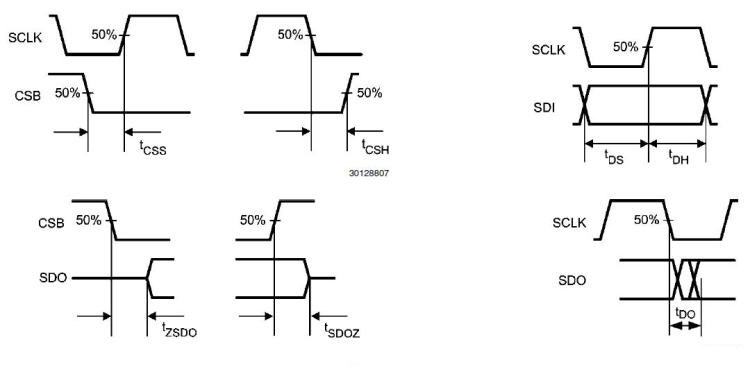 Figure 1. SPI Timing Diagrams
Figure 1. SPI Timing Diagrams
7.7 Typical Characteristics
Unless otherwise noted, data presented here was collected under these conditions VA = VD = 3.3 V, TA = 25°C, external bipolar transistor: 2N3904, RE = 22 Ω, C1 = C2 = C3 = 2.2 nF.